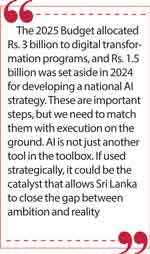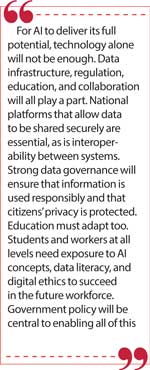Monday Dec 15, 2025
Monday Dec 15, 2025
Friday, 24 October 2025 00:20 - - {{hitsCtrl.values.hits}}

The question for Sri Lanka is not whether AI will shape our future, but whether we can use it to move faster than the path we are currently on
 A defining question for the decade ahead
A defining question for the decade ahead
Artificial intelligence is reshaping our world, how governments deliver services, how businesses operate, and how people live. The question for Sri Lanka is not whether AI will shape our future, but whether we can use it to move faster than the path we are currently on. Can it help us skip slow stages of transformation and push us ahead in our digitisation journey?
Leapfrogging is not new. Countries like Kenya, with its M-Pesa mobile payments, India with its Aadhaar digital identity system, and Rwanda with drone-based medical deliveries, have all used technology to jump over traditional barriers to development. Mobile banking, for instance, brought financial services to millions without the need for physical branches. AI offers Sri Lanka a similar opportunity. If used strategically, it can accelerate digital transformation, strengthen the economy, and improve daily life.
Why digitisation matters now
Sri Lanka is at a crucial stage in its economic story. The economy grew by 5% in 2024, a sign of recovery after one of the worst financial crises in its history. Long-term resilience will depend on whether we modernise the systems that underpin the economy, the institutions, services, and infrastructure that determine how efficiently we work, how fairly we deliver services, and how competitive we are globally.
The digital economy already plays a significant role. It is valued at around $ 3.47 billion, or roughly 4.37% of GDP, and there is a plan to grow this share much further. The IT and business process management workforce is projected to expand from 125,000 in 2018 to 300,000 by 2024, and the Government aims to raise annual IT sector revenue from $ 1.2 billion to $ 5 billion by 2030. These targets are ambitious, but they also highlight the gap between where we are and where we need to be. Without faster digitisation, these goals will remain difficult to achieve.
The 2025 Budget allocated Rs. 3 billion to digital transformation programs, and Rs. 1.5 billion was set aside in 2024 for developing a national AI strategy. These are important steps, but we need to match them with execution on the ground. AI is not just another tool in the toolbox. If used strategically, it could be the catalyst that allows Sri Lanka to close the gap between ambition and reality.
The potential to solve real problems
The promise of AI lies in its ability to address the real, often frustrating barriers that slow down Sri Lanka’s digitisation efforts. Complex tax systems, slow government services, inefficient workflows, and widening skill gaps are not unique to us, but they hold us back more than they should. AI provides a way to tackle these issues at their root rather than layering new technology on top of old processes.
 For instance, consider the tax system; frequent changes to tax policy have made compliance increasingly complex for both businesses and individuals. Intelligent AI systems can now process legislation, calculate taxes, and flag potential errors before they occur. For businesses, embedding such tools into payroll and accounting processes could transform compliance from a challenge into a seamless routine.
For instance, consider the tax system; frequent changes to tax policy have made compliance increasingly complex for both businesses and individuals. Intelligent AI systems can now process legislation, calculate taxes, and flag potential errors before they occur. For businesses, embedding such tools into payroll and accounting processes could transform compliance from a challenge into a seamless routine.
Public service delivery is another area where AI could make an immediate difference. Citizens continue to face long queues, paper-based applications, and inconsistent service levels. Virtual assistants and chatbots, powered by AI, can respond to inquiries, guide users through online forms, and validate submissions before they reach a human officer. By handling these repetitive tasks, AI can free public sector employees to focus on complex cases while improving the speed and accuracy of government services.
The same principle applies to other vital sectors. In healthcare, AI can support diagnostic processes, automate administrative tasks, and help allocate resources where they are most needed. In agriculture, AI helps farmers through precision farming, optimised planting schedules, and accurate weather predictions to improve yield and resource efficiency. In logistics, AI helps forecast demand, optimise warehouse operations, and improve delivery efficiency. Each of these improvements may seem incremental, but taken together, they represent a significant acceleration of the digital transformation process.
Building a workforce for the future
One of the biggest challenges Sri Lanka faces is the mismatch between the skills employers need and the skills the workforce currently offers. Many companies are struggling to recruit digital talent, while others lose their best employees to opportunities abroad. AI can play a role here by helping organisations plan better. Predictive analytics can identify emerging skill gaps, highlight future talent needs, and even recommend targeted training programmes to close those gaps.
Yet this opportunity comes with a challenge of its own. Generative AI, which can write code, generate text, and analyse data, is changing the nature of work. It allows teams to produce more in less time, but it also risks eroding the traditional learning process. Junior employees who once learned by writing code or drafting reports may now rely too heavily on automation, resulting in weaker foundational skills. If AI is to support, rather than undermine, workforce development, companies must think carefully about how they integrate it into daily workflows. The goal should be to use AI to enhance human capability, not replace the need for it.
Lessons from early adoption
There are already examples of how AI is changing the way organisations work. In software development, AI-powered coding tools are helping teams write, review, and optimise code more efficiently. This reduces errors, shortens project timelines, and improves product quality. Yet it is not a case of machines replacing humans. Developers remain at the centre of the process, guiding the technology and making the final decisions. This model, where humans and AI work together, is likely to define the future of most industries.
The rise of local innovation
A promising sign is that Sri Lankan companies themselves are beginning to design AI solutions tailored to the country’s specific challenges. Innovative firms like hSenid are quietly building the foundation for a smarter digital future. In one recent prototype demonstration for an overseas client, the company showcased how a property purchasing system could automatically scan, categorise, and validate uploaded files using AI. Instead of requiring a team of staff to manually check each submission, the system identified missing information, checked for inconsistencies, and flagged files for review.
 Academic institutions such as the University of Moratuwa and the Open University of Sri Lanka are experimenting with AI-powered chatbots to support students with admissions, course details, and exam information, significantly reducing the volume of queries handled manually. In the private sector, real estate platforms like LankaPropertyWeb and Ikman use conversational AI tools to match users with listings and respond to property-related inquiries around the clock. Several leading retail and e-commerce businesses, including Keells and Daraz Sri Lanka, also deploy AI to personalise recommendations, forecast demand, and streamline their customer support operations.
Academic institutions such as the University of Moratuwa and the Open University of Sri Lanka are experimenting with AI-powered chatbots to support students with admissions, course details, and exam information, significantly reducing the volume of queries handled manually. In the private sector, real estate platforms like LankaPropertyWeb and Ikman use conversational AI tools to match users with listings and respond to property-related inquiries around the clock. Several leading retail and e-commerce businesses, including Keells and Daraz Sri Lanka, also deploy AI to personalise recommendations, forecast demand, and streamline their customer support operations.
This approach offers a clear lesson for Sri Lanka’s own bureaucratic systems. Many government services still rely on paper submissions, manual verification, and repetitive review processes. By applying similar AI-driven automation, these services could become faster, more accurate, and far less resource-intensive. It is precisely in areas like this, where digitization has traditionally stalled due to administrative complexity, that AI offers the greatest potential to leap ahead.
There is also growing innovation in customer experience automation. hSenid is currently developing an AI assistant called Sprout AI, which can automatically crawl a company’s website, read inventory or service information, and answer customer questions instantly. Instead of requiring staff to manually check stock levels, product details, or policy information, the system provides accurate answers in real time. Sprout is already being applied beyond e-commerce, supporting clients in banking, real estate, and education by handling large volumes of queries and delivering instant, reliable responses. This has significant implications for other service industries like insurance and healthcare too, where rapid response and 24/7 engagement can make a decisive difference in customer satisfaction and retention.
What makes these examples important is not just their novelty but their scalability. If such systems can be adapted across sectors, from property and education to manufacturing and logistics, they can deliver transformative gains in efficiency and customer experience. They also show that local companies are capable of building solutions that compete globally while addressing challenges that are uniquely Sri Lankan. Perhaps most importantly, they highlight the value of homegrown innovation. Foreign-developed systems will always have a role, but domestic companies understand local regulations, languages, cultural nuances, and consumer expectations far more deeply. They can design solutions that are not only technologically sound but also practical for the realities on the ground. This combination of global capability and local insight is what will allow Sri Lanka to build a digital ecosystem that is resilient, inclusive, and sustainable in the long term.
Unlocking hidden value in the back office
While customer-facing applications attract the most attention, the biggest gains from AI may come from areas most people never see. Many back-office processes remain manual, slow, and prone to error. Payroll, procurement, compliance, and financial reporting are still handled by people in ways that have not changed for decades. Automating these processes can deliver immediate benefits. It can reduce costs, minimise human error, and generate data that organisations can use to make better strategic decisions.
For small and medium-sized enterprises, this could be transformative. SMEs make up the backbone of Sri Lanka’s economy, but often lack the resources to implement advanced digital solutions. AI can provide them with access to capabilities once reserved for large corporations. This levelling of the playing field is essential if the benefits of digitisation are to be widely shared across the economy.
The importance of language and access
One of the biggest barriers to digital adoption in Sri Lanka is language. Many of the most powerful AI tools are designed for English, which limits their usefulness for a large part of the population. Encouragingly, research from the University of Moratuwa on Sinhala-language AI models is showing promising results. These models can power virtual assistants, legal document review systems, and customer support tools that understand and respond in local languages. They are also crucial for making digital public services more inclusive.
Access is another challenge. Around 56% of Sri Lankans are online, which means nearly half the population still lacks reliable internet access. Digitisation strategies must include plans to bridge this gap. If they do not, AI will deepen existing inequalities rather than reduce them.
The foundations for success
For AI to deliver its full potential, technology alone will not be enough. Data infrastructure, regulation, education, and collaboration will all play a part. National platforms that allow data to be shared securely are essential, as is interoperability between systems. Strong data governance will ensure that information is used responsibly and that citizens’ privacy is protected. Education must adapt too. Students and workers at all levels need exposure to AI concepts, data literacy, and digital ethics to succeed in the future workforce.
Government policy will be central to enabling all of this. Clear regulatory frameworks can help build public trust while encouraging innovation. Incentives for research and development, support for local language models, and partnerships between government, academia, and industry can all accelerate progress. Collaboration will be vital. No single actor can build the ecosystem required for AI-driven digitisation. Success will depend on collective effort.
A realistic view of what AI can and cannot do
It is important to remain realistic. AI is not a silver bullet. It cannot solve structural problems overnight or replace the need for good governance, sound policy, and capable institutions. It is a tool, a powerful one, but still a tool, whose value depends on how well it is integrated into broader strategies for growth and reform. It requires quality data, human oversight, and carefully designed systems to succeed.
Yet the opportunity is undeniable. Sri Lanka already ranks 95th out of 193 countries in the Government AI Readiness Index, an improvement of ten places in a single year. This progress shows momentum, but it also highlights how far we still have to go. If we get the fundamentals right, AI could help us accelerate not just digitisation, but national development itself.
Moving forward with purpose
The road ahead will not be easy, but it’s very exciting. But if Sri Lanka uses AI wisely, the rewards could be profound. We could bypass years of incremental change and build systems that are efficient, inclusive, and ready for the future. Public services could become faster and more transparent. Businesses could operate with greater agility and competitiveness. Citizens could gain access to opportunities that once felt out of reach.
Achieving this vision will require leadership from every part of society. We need a clear direction with strong data governance, ethical frameworks, and incentives for innovation. Businesses must look beyond short-term productivity gains and invest in AI capabilities that create lasting competitive advantage. Academic institutions must rethink curricula and research priorities to align with the demands of a digital-first economy. In addition, the public must be empowered with the skills and confidence to interact with intelligent systems in their daily lives.
COYLE organised a ‘Practical Approach to AI’ event on the 2nd of October in Colombo, bringing together experts and business leaders to explore how organisations can adopt AI effectively. Industry expert Sanjeev Jain from Delhi delivered a compelling session on how AI can significantly enhance productivity across various departments within an organisation. Rather than taking a broad-brush approach, he emphasised the importance of understanding and applying AI solutions in a department-specific manner, tailoring tools and strategies to the unique needs and workflows of each function.
Events like this are vital for building awareness, sharing practical insights, and connecting stakeholders who can accelerate Sri Lanka’s digital transformation.
The decisions we make now will determine whether AI becomes just another technology trend or a transformative force in Sri Lanka’s development.
The tools are available, the talent exists, and the ambition is clear. What remains is the collective will to act with foresight and to invest in a future where technology works for everyone.
(Dishnira Saparamadu-Ariyarathne is Director, hSenid Mobile Solutions Ltd., and Chinthaka Abeysekera is State Affairs Committee Chairman and Sisili Projects Consortium Ltd. Managing Director.)